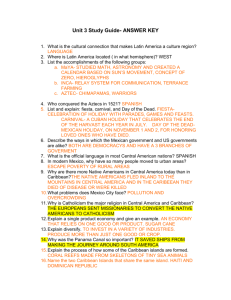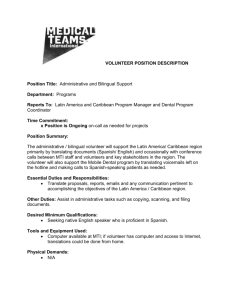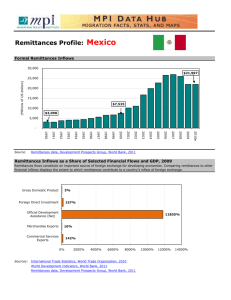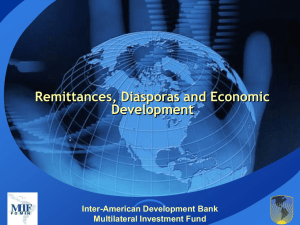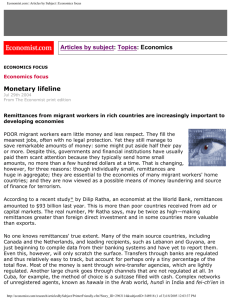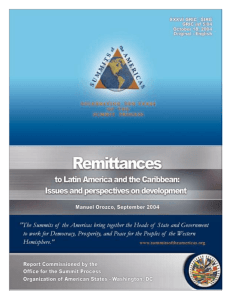ECLAC: Fact-Sheet on the Economic Crisis and Migration in Latin
advertisement
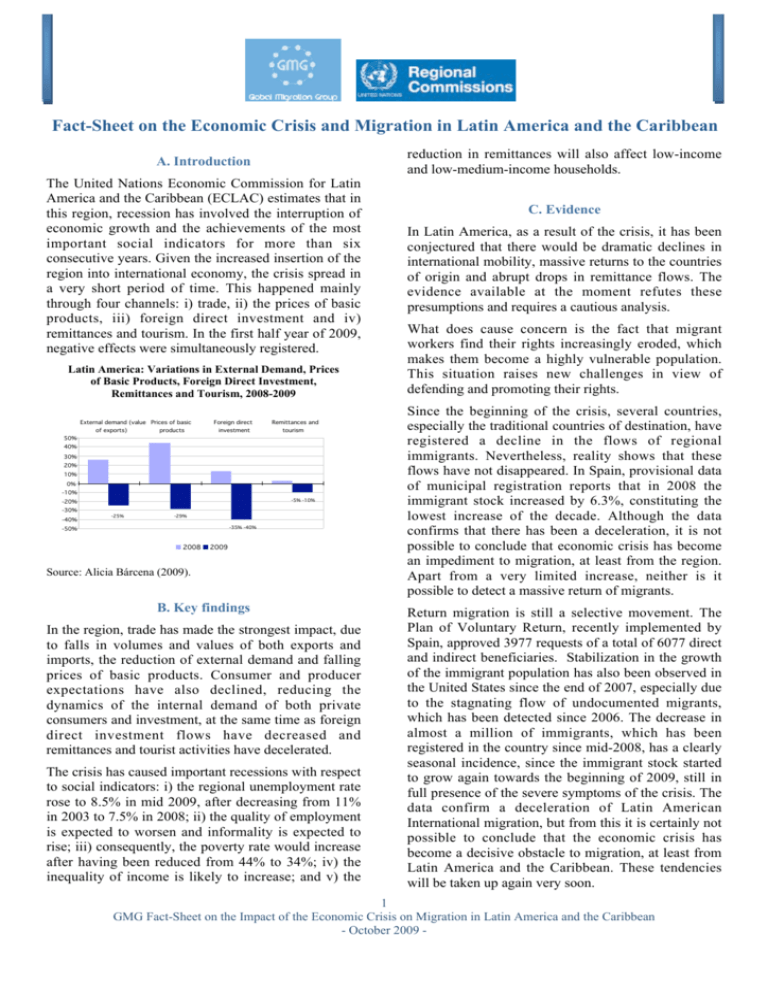
Fact-Sheet on the Economic Crisis and Migration in Latin America and the Caribbean reduction in remittances will also affect low-income and low-medium-income households. A. Introduction The United Nations Economic Commission for Latin America and the Caribbean (ECLAC) estimates that in this region, recession has involved the interruption of economic growth and the achievements of the most important social indicators for more than six consecutive years. Given the increased insertion of the region into international economy, the crisis spread in a very short period of time. This happened mainly through four channels: i) trade, ii) the prices of basic products, iii) foreign direct investment and iv) remittances and tourism. In the first half year of 2009, negative effects were simultaneously registered. Latin America: Variations in External Demand, Prices of Basic Products, Foreign Direct Investment, Remittances and Tourism, 2008-2009 External demand (value Prices of basic of exports) products Foreign direct investment Remittances and tourism 50% 40% 30% 20% 10% 0% -10% -5% -10% -20% -30% -40% -25% -29% -35% -40% -50% 2008 2009 Source: Alicia Bárcena (2009). B. Key findings In the region, trade has made the strongest impact, due to falls in volumes and values of both exports and imports, the reduction of external demand and falling prices of basic products. Consumer and producer expectations have also declined, reducing the dynamics of the internal demand of both private consumers and investment, at the same time as foreign direct investment flows have decreased and remittances and tourist activities have decelerated. The crisis has caused important recessions with respect to social indicators: i) the regional unemployment rate rose to 8.5% in mid 2009, after decreasing from 11% in 2003 to 7.5% in 2008; ii) the quality of employment is expected to worsen and informality is expected to rise; iii) consequently, the poverty rate would increase after having been reduced from 44% to 34%; iv) the inequality of income is likely to increase; and v) the C. Evidence In Latin America, as a result of the crisis, it has been conjectured that there would be dramatic declines in international mobility, massive returns to the countries of origin and abrupt drops in remittance flows. The evidence available at the moment refutes these presumptions and requires a cautious analysis. What does cause concern is the fact that migrant workers find their rights increasingly eroded, which makes them become a highly vulnerable population. This situation raises new challenges in view of defending and promoting their rights. Since the beginning of the crisis, several countries, especially the traditional countries of destination, have registered a decline in the flows of regional immigrants. Nevertheless, reality shows that these flows have not disappeared. In Spain, provisional data of municipal registration reports that in 2008 the immigrant stock increased by 6.3%, constituting the lowest increase of the decade. Although the data confirms that there has been a deceleration, it is not possible to conclude that economic crisis has become an impediment to migration, at least from the region. Apart from a very limited increase, neither is it possible to detect a massive return of migrants. Return migration is still a selective movement. The Plan of Voluntary Return, recently implemented by Spain, approved 3977 requests of a total of 6077 direct and indirect beneficiaries. Stabilization in the growth of the immigrant population has also been observed in the United States since the end of 2007, especially due to the stagnating flow of undocumented migrants, which has been detected since 2006. The decrease in almost a million of immigrants, which has been registered in the country since mid-2008, has a clearly seasonal incidence, since the immigrant stock started to grow again towards the beginning of 2009, still in full presence of the severe symptoms of the crisis. The data confirm a deceleration of Latin American International migration, but from this it is certainly not possible to conclude that the economic crisis has become a decisive obstacle to migration, at least from Latin America and the Caribbean. These tendencies will be taken up again very soon. 1 GMG Fact-Sheet on the Impact of the Economic Crisis on Migration in Latin America and the Caribbean - October 2009 - Fact-Sheet on the Economic Crisis and Migration in Latin America and the Caribbean Remittances With respect to remittances, the World Bank and the Inter-American Development Bank (IADB) show that behaviour keeps fluctuating. While volumes have declined considerably since the last quarter of 2008 it is not possible to observe a phenomenon of collapse. The World Bank stated that from 2007 to 2008, remittance flows worldwide showed a strong countercyclical character, with constant levels in spite of the severe falls in private capital flows to developing countries. IADB pointed out that in the year of 2008, the region was the one that received the highest amount of remittances in the world, even though it had registered its first decrease in the first quarter of the year, after a decade of constant growth. In comparative terms, the region has been the most affected one in the world with respect to the growth of remittance flows, which is explained by the strong relative participation of Latin Americans in the labour market of the United States. Quarterly evolution of remittances received in selected countries of Latin America and the Caribbean, 2003-2009 (US$ thousand) 1,400.0 1,200.0 1,000.0 800.0 600.0 400.0 200.0 - Guatemala El Salvador D. Republic Honduras Jamaica Source: Migration and Remittances Team, Development Prospects Group, World Bank. D. Policy Implications For two reasons, the information available until 2009 calls for caution in the analysis of the impacts of the crisis on remittances: purchasing power of receiving households. This issue remains to be analyzed and should not be neglected. Bibliography Bárcena, Alicia (2009), “La política en tiempos de crisis”, Seminario Iberoamericano sobre Políticas Sociales en Tiempos de Crisis, Asunción, Paraguay, 6 de agosto de 2009. ECLAC (2009), Notas sobre Migración Internacional y Desarrollo: América Latina y el Caribe y la Unión Europea. Documento elaborado para la Reunión de Alto Nivel de Funcionarios de Migración (Bruselas, 25 de septiembre de 2009), Santiago de Chile. Kacef, Osvaldo y Juan Pablo Jiménez (comps.) (2009), “Políticas macroeconómicas en tiempos de crisis: opciones y perspectivas”, Documento de Proyecto, Santiago de Chile, CEPAL. Martínez, Jorge (2008) (ed.), América Latina y el Caribe: migración internacional, derechos humanos y desarrollo, Libros de la CEPAL, 97 (LC/G.2358-P), Santiago de Chile, CELADE-CEPAL. Publicación de las Naciones Unidas, Nº de venta: S.08.II.G.5. Orozco, Manuel y Ana Ferro (2009) (eds.), “Worldwide Trends in International Remittances”, Migrant Remittances Newsletter, Vol. 6, 1, USAID’s Microenterprise Development Office y DFID (Department for International Development). Papademetriou, Demetrios G. y Aaron Terrazas (2009), “Immigrants in the United States and the Current Economic Crisis”, Migration Information Source, Migration Policy Institute (MPI). Prepared by the United Nations Regional Commissions For further information, please contact: Economic Commission for Latin America and the Caribbean (ECLAC), CELADE – Population Division, Jorge.martinez@cepal.org First, because of the clearly seasonal incidence of the negative percentages of fluctuations and variations that can be registered in the main receiving countries of the region. Second, because in spite of the decrease in received volumes in U.S. dollars, the effect on the consumption of some countries has been dampened due to the depreciation of the local currency, which has raised the 2 GMG Fact-Sheet on the Impact of the Economic Crisis on Migration in Latin America and the Caribbean - October 2009 -

